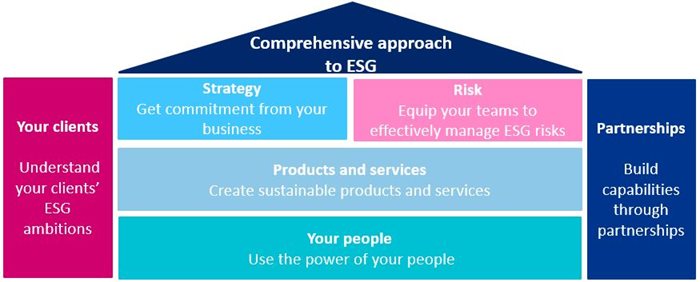
The six key challenges of building your ESG capability – you’re not starting from zero
9 May 2022
Financial institutions are uniquely positioned to use their influence to drive truly sustainable outcomes for themselves, the planet and society. Bloomberg recently stated that the ESG market is set to ‘balloon to a total value of $50 trillion by 2025' and 88% of investors believe that organisations that prioritise ESG are a better long-term investment, further driving the trend that ESG and Sustainability in financial services is fast becoming the norm.
Organisations who have been successful with ESG are taking a comprehensive implementation approach, which considers the full breadth of topics, from carbon emissions to employee wellbeing, not in isolation but in relation to each other and considering them at every level of business. This is paramount because ESG isn’t just another box to tick – it is the new way of operating that considers the triple bottom line: people, profit and planet.
How can financial institutions comprehensively embed ESG? By leveraging existing capabilities
It might seem daunting to consider ESG at every level of your business, while at the same time rethinking your bottom line, but you don’t have to start from scratch. Financial institutions can take advantage of existing capabilities built to tackle net zero and climate change and expand these to support their ESG outcomes.
We have simplified the process down to six key questions that we hear from our clients when it comes to operationalising a successful ESG program:

1. How do you ensure ESG remains a core part of your strategy?
Tying your overarching strategy to sustainable outcomes can deliver positive financial, social and environmental outcomes for your stakeholders.
ESG needs to flow through your entire business strategy, with firmwide buy-in to support this. Connecting executive incentives to sustainability KPIs may help to encourage leadership commitment, as seen with Mastercard, who announced that they will be tying ESG KPIs to the compensation of their entire workforce.
You will need to build and maintain strong governance and executive accountability with quality Management Information to make the best strategic decisions. Most financial institutions have appointed executive sponsorship for climate risk (SMF) and some have broadened the scope of their role to wider sustainability risk considerations.
In addition, to build credibility, you should continually disclose your results and progress through your sustainability reports. Whilst some elements of the E in ESG are mandatory to disclose, for example, TCFD and the SEC’s new climate risk proposed ruling, being transparent about your progress on the wider E, S & G will help keep your strategy on track. You may also consider alignment to industry standards such as SASB & GRI, or ISSB to future proof your business.
2. How to make sure your ESG strategy and risk management work successfully together?
To best equip your teams to tackle ESG risk, put in place distinct accountability, frameworks and training to make for productive and pragmatic decisions.
ESG risk and ESG impact are different, and the accountabilities for these should therefore be distinct. The CRO should typically be accountable for setting the standards for managing ESG risks; while others, such as the CSO or CFO, should be accountable for managing the impact of the organisation on the planet and society. They should work together to ensure alignment and balance, but they are two separate considerations. With this in place, organisations can use climate change capabilities as a springboard for developing wider ESG risk capabilities. Climate risk has become one of the top priorities for CROs and their teams over the last few years due to pressure from regulators such as the PRA and ECB who have pushed heavily to embed climate change into financial institutions’ risk management processes. Use these frameworks, data and KPI strategies etc. and widen out to broader ESG risks. There will be a heavy focus over the next few years in particular on the wider environmental risks such as nature and biodiversity loss, given their existential impact on humanity.
One final point to note, recognise that risk management is as much about the “English essay” as the “maths question”. Whilst it is, of course, necessary to have the data and risk measurement frameworks in place it is also key to stimulate the right conversations – and healthy tensions – between the Board and executive management of the business; and between the businesses and the central functions. Enabling this conversation requires not just data but also qualitative understanding through training and experience.
3. How to build knowledge and maximise your impact?
The journey to sustainability is not a solo one, lean in and learn from the expertise and influence of others.
The power of partnerships is widely supported, with the UN listing this as number 17 in their Sustainable Development Goals (SDGs) recognising partnerships as a way to maximise progress. Look for partners across the eco-system with whom to share knowledge, build joint capabilities, and maximise impact. A great example is how the SDGs are being operationalised through the UN Global Compact, a 15,000+ company strong initiative based on CEO commitments to encourage responsible business and strategic action to advance societal goals. Additionally, BNP partnered with Clarity AI, a sustainability data science and tech company to allow their clients to access ESG data and insights to support their ESG risk capabilities. These partnerships not only facilitate sharing of expertise but also encourage the participants to be more ambitious and holds them accountable for their progress publicly.
4. How to best use the power of your people?
Build upon the momentum and passion of your people and equip them with the necessary skills and opportunities to be part of positive change.
Companies increasingly face pressure from their employees to be part of the solution for environmental and social issues, with 67% agreeing that sustainability is an important factor when attracting and retaining talent. Not doing so can result in a dissatisfied and ineffective workforce with high attrition. We saw this during the height of the 2021 Black Lives Matter protests which saw a backlash against corporates failing to be part of the change, including Meta’s, formally Facebook, staff staging a virtual walkout after CEO, Mark Zuckerberg failed to take action against Trump. Forming and communicating your organisation’s ESG goals presents an opportunity to create confident, invested and purpose-lead teams. A key accelerator to this is establishing a base level of knowledge among colleagues, as seen in Bank of England mandates of board climate risk training, which is essential to transformation.
5. How to bring your clients on the journey?
For both existing and future clients it is critical to understand where they are on their ESG journey and whether this aligns with your organisation’s standards.
Post CBES and the EU Stress testing, the world’s largest banks embarked on mass engagements to assess their client’s net zero plans, including Standard Chartered Bank (SCB), who with our support, engaged 2,000 of their top clients. To do this successfully, client engagement programmes had to be set up and relationships built between SCB and their client representatives to gauge an accurate reflection of their positions and where they can improve. Beyond net zero alignment, major financial institutions, such as Schroders and their recent Engagement Blueprint announcement, have started asking a wider set of ESG related questions and setting stricter requirements for acceptance of new clients. Key ESG themes such as board-level diversity and sustainable supply chains are becoming indicators of potential clients’ commitment to sustainability and therefore how well they are futureproofing themselves against rising market and regulatory standards. Embed these considerations into onboarding decisions, as well as ongoing client engagements and define what real sustainability looks like for your clients. This framework can then be used in client base growth strategies.
6. How to create sustainable products and services?
Capitalise on the innovative thinking from Green products and bring environmental and social agendas to the table. The Green Bond market reached half a trillion USD in 2021. With the emergence of other green finance products, including EPC linked Mortgages, Green Bonds have been an essential accelerator in getting the world to net zero as they provide incentives for customers to make more carbon-conscious decisions. Expand these green incentives to wider ESG related topics and as a result, you can tap into underserved segments, for example, Legal & General’s launch of an affordable housing arm to help people on the property ladder. Whether the focus is on pure ESG product development, or on applying an ESG lens to new and existing products, recognise what the social and environmental impact of these products is.
Addressing ESG successfully should not be taken lightly. By already having a net zero and climate strategy, you have an advantage. Fuelled with the passion of your people and paired with a comprehensive approach, leverage these capabilities to ensure you maximise your ESG value potential.
Does your ESG strategy consider the birds-eye view of your business?
Standard Chartered’ s Net Zero white paper: https://av.sc.com/corp-en/content/docs/SC-net-zero-whitepaper.pdf
Climate Bond Market Intelligence $500bn Green Issuance 2021: social and sustainable acceleration: Annual green $1tn in sight: Market expansion forecasts for 2022 and 2025 | Climate Bonds Initiative
Legal & General launches affordable housing arm | Legal & General (legalandgeneral.com)
To find out more about how we can help you, please contact us.
Our Experts

Related Insights

Future-proofing climate disclosures: Leveraging climate reporting for nature
Forward-thinking companies are integrating climate and nature into their strategies to drive innovation and resilience.
Read more
Transition planning in turbulent times: How financial institutions can adapt and lead
The shift to a low-carbon economy is challenging for financial institutions; we explore how they can adapt and lead in today's tough landscape.
Read more
Simplification Omnibus: what you need to know and where to go from here
We share what the Simplification Omnibus means for CSRD, CS3D and the EU Taxonomy and how you should respond.
Read more
2025 Outlook: What lies ahead for climate and sustainability in financial services?
Here's what's front of our minds for 2025 based on our dialogue with, and work for, climate and sustainability leaders across financial institutions.
Read moreIs digital and AI delivering what your business needs?
Digital and AI can solve your toughest challenges and elevate your business performance. But success isn’t always straightforward. Where can you unlock opportunity? And what does it take to set the foundation for lasting success?